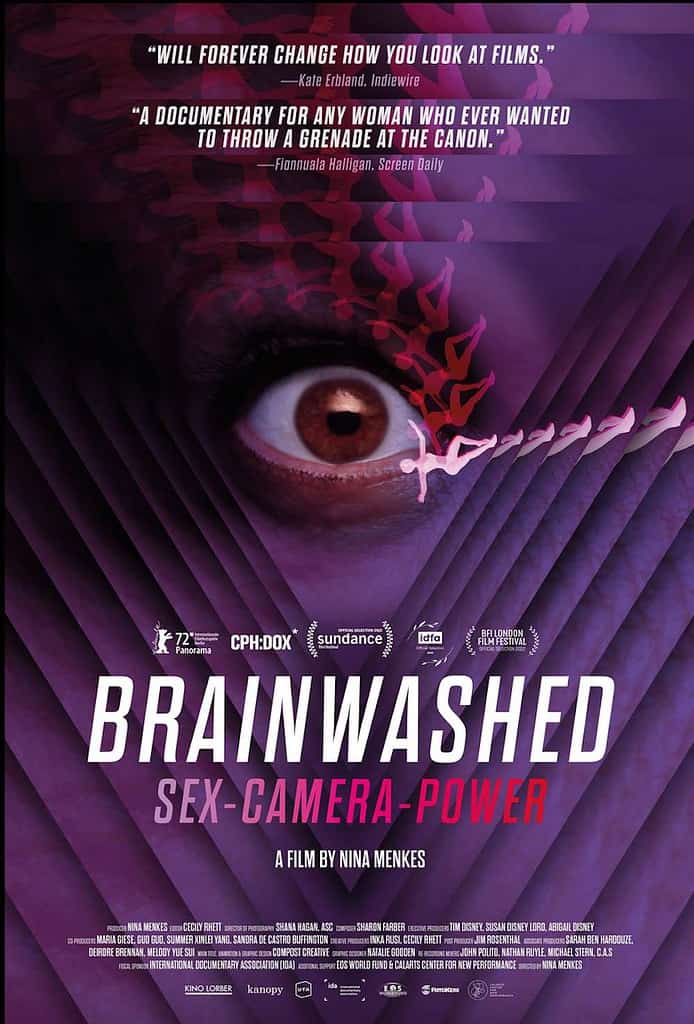From writer and director Nina Menkes, Brainwashed: Sex-Camera-Power explains how the politics of shot design on our screens affects sexual assault and employment discrimination against women. The documentary uses over 175 film clips to make its point.
Brainwashed: Sex-Camera-Power is so well organized and explored it will wake you from a long slumber regarding the treatment of women on screens. It makes me want to rewrite many of the reviews I have written for this blog, although I’m not going to do that.

The film was organized like a TED talk or a speech by Nina Menkes. There were five main points, which I’ll talk about in a bit. Comments about each of the five main points were illustrated with film clips. People who spoke included Rosanna Arquette, Julie Dash, Catherine Hardwicke, Ita O’Brien, numerous other Hollywood leaders, and several academics in the film realm.
Point 1: Subject/Object
The phrase “male gaze” means the man is the subject. A man watches a woman. The man is taking the action. The object of that action is the woman. The woman is objectified. The point of view (POV) is the man’s.
Watching films that objectify women literally trains your brain to regard women as passive objects. The documentary called this quality “to-be-looked-at-ness.”
The point of view moves like this: audience -> male director -> male director of photography -> male protagonist -> female object.
Point 2: Framing
Women are often framed as fragmented body parts – butts, lips, breasts, legs – without even showing the woman’s face at all. It’s a man’s point of view, looking at the woman on display before him.
By contrast, when men are shown as sexy, they are shot full body and doing something active. Think of Magic Mike and men prancing shirtless on a stage.
Point 3: Camera Movement
Often the camera moves over the woman’s body in slow motion, further emphasizing that her body is nothing more than an object to be admired and owned. When scenes involving men are shown in slow motion it’s usually a battle scene or a fight scene.
Point 4: Lighting
While men are anchored in space with 3D lighting, women are often used like beautiful 2D portraits. Beautiful but not part of the action going on around them.
Point 5: Narrative Position
The women are passive and powerless in the narrative. The women are not self-acting agents, but objects.
As these points were being made, there were many interesting remarks and illustrations. If the camera is predatory, it trains the culture to be predatory. That translates into glamorizing sexual assault and creating the language of rape culture.
It translates into the devaluing of women in the workplace. Something like 94% of the women working in the film industry both in front of and behind the camera have suffered sexual attacks.
The male gaze is so pervasive in our world, it’s like the air we breathe. It’s so imprinted on us, we don’t even notice it. Examples of films made by women directors that use the male gaze were shown.
Toward the end of the documentary, there were several examples of films that did not rely on the male gaze. A few of them were Portrait of a Lady on Fire, Nomadland, A Girl Walks Home Alone at Night, Promising Young Woman, Orlando, and The Watermelon Woman. I’d like to add the recently released Women Talking and The Woman King.
I watched the film on Prime Video. This is a must see film, not just for women. Men need to open their minds to this as well. Nothing will change if they don’t.

Leave a Reply